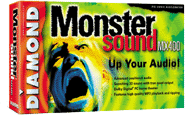Diamond Monster Sound MX400
by Mike Andrawes on January 27, 2000 2:08 AM EST- Posted in
- Smartphones
- Mobile
 The
Diamond Monster 3D was debatably the most popular graphics card based on the
3dfx Voodoo Graphics chipset. It helped make the name "Voodoo" synonymous
with fast 3D acceleration during that time frame. For those that don't remember,
the Monster 3D, like other Voodoo Graphics cards, was a dedicated 3D-only graphics
card. When it was time for Diamond to release a PCI sound card line, they decided
to capitalize on the "Monster" branding that they had established.
Hence, the Monster Sound was born.
The
Diamond Monster 3D was debatably the most popular graphics card based on the
3dfx Voodoo Graphics chipset. It helped make the name "Voodoo" synonymous
with fast 3D acceleration during that time frame. For those that don't remember,
the Monster 3D, like other Voodoo Graphics cards, was a dedicated 3D-only graphics
card. When it was time for Diamond to release a PCI sound card line, they decided
to capitalize on the "Monster" branding that they had established.
Hence, the Monster Sound was born.
Like the Monster 3D, the original Monster Sound was a pioneer in its field. It was one of the first PCI sound cards, one of the first to offer A3D support, and one of the first to eschew Sound Blaster compatibility. Diamond realized that the DOS gaming world was not completely dead and afford a pass through for your old ISA sound card, which would continue to provide Sound Blaster compatibility if so desired.
3D positional audio came courtesy of Aureal's A3D API. Rather than use Aureal's hardwired A3D 1.0 accelerator, Diamond went with a custom DSP solution, which allowed them to augment A3D 1.0 with quad speaker support. That original Monster Sound was followed by the Monster Sound MX200, which improved the line with a few additional features, but remained mostly the same.
As with just about anything else in this industry, Aureal had to improve on their original A3D 1.0 API. When it was time for Diamond to update their product line for A3D 2.0, they decided to use Aureal's own AU8830 Vortex 2 chip on their own custom board design. Thus, the Monster Sound MX300 came to see the light of day.
The MX300 was released at about the same time as Creative's first entry into the 3D sound market, the Sound Blaster Live!, really help to legitimize the 3D sound market. The Live!, with it's support for Creative's own EAX API, also offered the first real competition for Aureal. While the EAX API was relatively late to the game, it came from Creative Labs, the inventor of the Sound Blaster line that is so well known throughout the industry. Further, it was much easier to program for EAX than A3D. On the other hand, Aureal claimed A3D, especially A3D 2.0, offered more realistic 3D audio. As you can probably guess, this is when the battles down in the trenches really started to heat up.
Last fall, Aureal decided to go produce self-branded Vortex 2 cards, starting with the Aureal SQ2500. There was nothing really special about the SQ2500 compared to other all the other Vortex 2 cards out there, but the move only made sense since Aureal was actually manufacturing all Vortex 2 cards, including Diamond's custom MX300 design. More importantly, all those Aureal OEM's were now effectively out of the Vortex 2 market.
Once again, Diamond capitalized on the Monster branding as they teamed up with ESS for the latest edition to this famed series, the Monster Sound MX400. Simply by having a higher model number, many consumers will automatically assume that the MX400 is better than the MX300, but remember that Diamond was effectively forced to change their high-end sound card. Let's take a look at what Diamond can do with the ESS Canyon3D to see if it's really better.










0 Comments
View All Comments